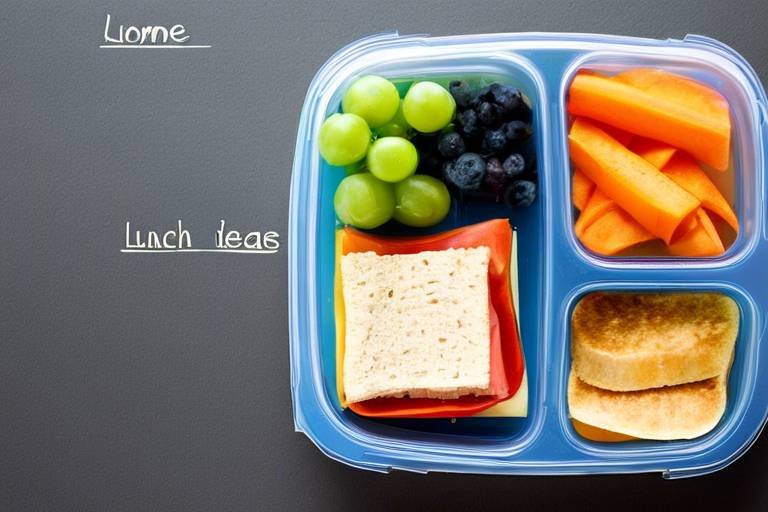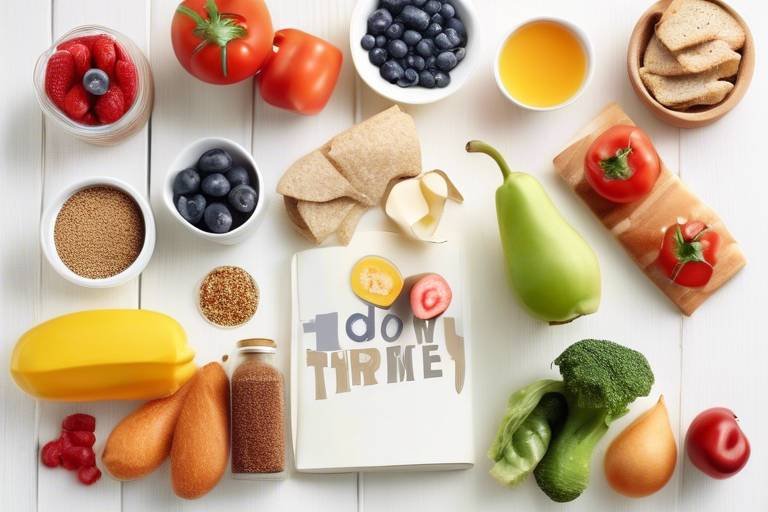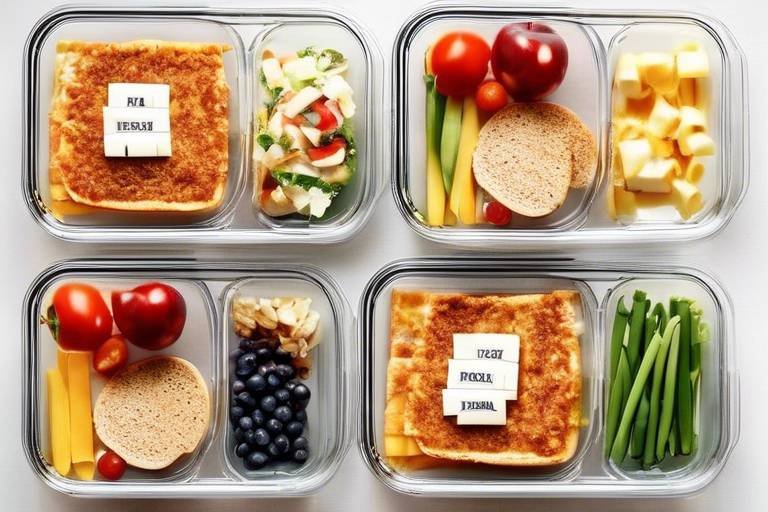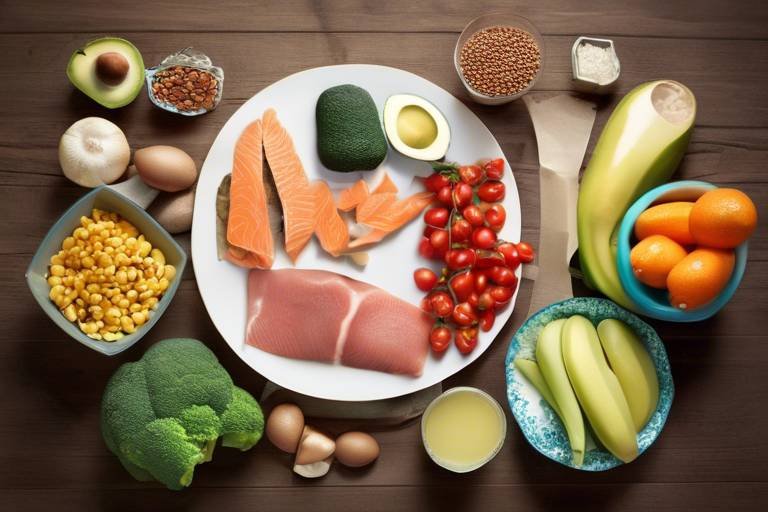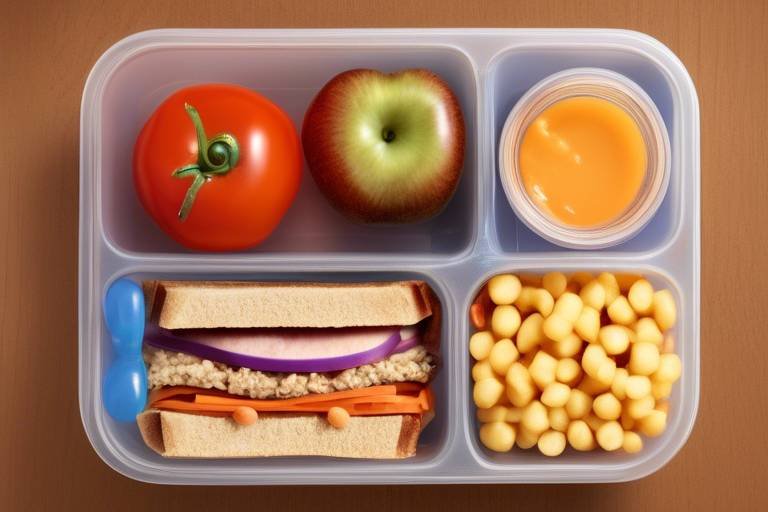Planning Your Family’s Weekly Meals on a Budget
Are you tired of watching your grocery bills soar while still trying to provide nutritious meals for your family? If so, you’re not alone! Many families face the challenge of balancing their budgets with the need for delicious and healthy food. This article provides practical strategies for planning nutritious and affordable meals for your family, helping you save money while ensuring everyone enjoys delicious food throughout the week. Let’s dive in and discover how you can transform your meal planning without breaking the bank!
Establishing a clear budget is essential for effective meal planning. Start by evaluating your finances; take a close look at your income and expenses. You might be surprised to see where your money goes! Setting realistic spending limits for groceries can help you stay on track. Consider using a simple budget template to keep your finances organized. For example, you can allocate a specific amount for each category:
| Category | Monthly Budget |
|---|---|
| Groceries | $400 |
| Dining Out | $100 |
| Snacks | $50 |
By knowing your limits, you can make more informed decisions at the grocery store, ensuring that your family eats well without overspending.
A well-structured weekly menu can streamline your cooking process and save you precious time during the week. Start by sitting down with your family and discussing their favorite meals. This way, you can plan meals that suit your family's tastes while adhering to your budget constraints. A simple menu might look like this:
- Monday: Spaghetti with homemade marinara sauce
- Tuesday: Taco night with ground turkey
- Wednesday: Stir-fried vegetables and rice
- Thursday: Baked chicken with seasonal veggies
- Friday: Pizza night with homemade dough
By planning meals in advance, you can ensure that you have all the ingredients on hand and avoid those last-minute takeout temptations that can quickly drain your budget.
Utilizing leftovers creatively can minimize waste and save money. Instead of letting those extra servings go to waste, think about how you can repurpose them into new, enjoyable meals. For instance, leftover roasted chicken can be transformed into a hearty chicken salad or used in a flavorful soup. Get creative! Here are some ideas:
- Use leftover vegetables in a frittata.
- Make a stir-fry with leftover rice and protein.
- Turn extra pasta into a cold pasta salad for lunch.
By incorporating leftovers into your weekly menu, you not only save money but also reduce food waste, making your meal planning even more efficient.
Batch cooking allows you to prepare large quantities of food at once, which can save you time and energy throughout the week. Dedicate a few hours on the weekend to cook up a storm! You can make big pots of soups, stews, or casseroles that can be portioned out and stored for later. Here are some quick tips:
- Choose recipes that freeze well.
- Label containers with the date and contents.
- Use clear containers to easily see what you have.
Not only does batch cooking save time, but it also ensures that you have healthy meals ready to go, making it easier to stick to your budget.
Freezing meals can be a lifesaver for busy families. It allows you to prepare meals in advance and simply reheat them when needed. To properly freeze and reheat meals without sacrificing taste or texture, follow these steps:
- Cool meals completely before freezing.
- Use airtight containers or freezer bags to prevent freezer burn.
- Thaw meals in the refrigerator overnight before reheating.
By having a stockpile of frozen meals, you’ll always have a quick and nutritious option on hand, making it less likely that you’ll resort to expensive takeout options.
Smart grocery shopping is crucial for sticking to your budget. Here are some strategies to help you find the best deals:
- Make a shopping list based on your weekly menu.
- Use coupons and take advantage of store loyalty programs.
- Shop seasonally to get the best prices on fresh produce.
By being strategic about your shopping habits, you can maximize your savings and ensure that you’re getting the most bang for your buck.
Eating healthy on a budget doesn't have to be difficult. Discover affordable ingredient substitutions that maintain nutritional value while reducing costs. For example, consider using:
- Greek yogurt instead of sour cream.
- Brown rice instead of white rice.
- Frozen fruits and vegetables instead of fresh, particularly when out of season.
These small changes can greatly impact both your health and your wallet!
Choosing seasonal fruits and vegetables can significantly lower your grocery bills. Not only are they often cheaper, but they also taste better! Eating with the seasons means you’re getting produce at its peak freshness. Check out your local farmers' market or grocery store for the best seasonal selections. You’ll be amazed at how much you can save!
Understanding the difference between whole and processed foods can impact your health and budget. Whole foods, like fruits, vegetables, whole grains, and lean proteins, are typically less expensive than processed foods and offer greater nutritional benefits. By incorporating more whole foods into your meals, you can improve your family’s health while keeping costs down. Think of it this way: investing in whole foods is like planting seeds for a healthier future!
Q: How can I start meal planning on a budget?
A: Begin by evaluating your finances and setting a realistic grocery budget. Create a weekly menu that includes your family's favorite meals and stick to it while shopping.
Q: What are some tips for using leftovers effectively?
A: Get creative! Repurpose leftovers into new meals, such as using roasted chicken in a salad or turning extra pasta into a pasta salad.
Q: How can I find the best deals while grocery shopping?
A: Make a shopping list based on your meal plan, use coupons, and take advantage of store loyalty programs. Shopping for seasonal produce can also help cut costs.

Understanding Your Budget
Establishing a clear budget is essential for effective meal planning. It’s like laying the foundation of a house; without a solid base, everything else can crumble. First, take a moment to evaluate your finances. Gather your recent bank statements, receipts, and bills. This will give you a clear picture of where your money is going. You might be surprised to see how much you spend on groceries each month. The goal here is to set realistic spending limits for your grocery shopping that align with your overall budget.
Once you have a good understanding of your expenses, it’s time to determine a specific amount you can allocate to food each week. Consider factors such as the number of family members, their dietary needs, and how often you eat out versus cooking at home. A good rule of thumb is to aim for about 10-15% of your monthly income to be spent on groceries. This percentage can vary based on your personal circumstances, but it’s a solid starting point.
Next, it’s essential to track your spending. You can use a simple spreadsheet or budgeting app to keep tabs on your grocery expenses. This will not only help you stay within your budget but also allow you to identify areas where you can cut back. For example, if you notice that you’re spending a lot on snacks, you might decide to make more homemade options instead. Remember, every little bit counts!
To make your budgeting process even easier, consider creating a monthly meal plan. This involves planning out your meals for the entire month, which can help you shop more efficiently. When you know exactly what you need, you’re less likely to make impulse purchases at the store. Plus, having a plan reduces the stress of last-minute cooking decisions. You can allocate specific amounts for each week based on your meal plan, ensuring that you stick to your budget.
Finally, don't forget to account for unexpected expenses. Life can be unpredictable, and having a small buffer in your budget can save you from financial stress. Aim to set aside about 5-10% of your grocery budget for these unforeseen costs. This way, if you find yourself needing to buy extra ingredients for a last-minute meal, you won’t have to worry about breaking the bank.
By understanding your budget and planning accordingly, you can enjoy delicious meals with your family without the financial strain. Remember, budgeting isn’t about deprivation; it’s about making informed choices that allow you to enjoy life while being financially responsible.
- How can I cut down on my grocery bill? Start by planning your meals, making a shopping list, and sticking to it. Look for sales and use coupons when possible.
- What if my budget is too tight to buy fresh produce? Consider buying frozen fruits and vegetables, which are often just as nutritious and less expensive.
- How can I ensure my family is eating healthy on a budget? Focus on whole foods like grains, legumes, and seasonal produce, which are generally more affordable and healthier than processed options.

Creating a Weekly Menu
When it comes to planning meals for your family, is like setting the stage for a delicious performance. It not only helps you stay organized but also ensures that you have a variety of nutritious meals ready to go. Think of it as a roadmap for your culinary journey each week. The first step is to sit down and consider your family's preferences. What do they love to eat? Are there any dietary restrictions to keep in mind? By understanding these aspects, you can tailor your menu to suit everyone's tastes and needs.
Next, consider balancing your meals. A well-rounded menu should include a mix of proteins, vegetables, and grains. For instance, you might plan a chicken stir-fry one night, followed by a hearty vegetable soup the next. This not only keeps things interesting but also ensures that your family is getting a range of nutrients. It's like composing a symphony; every ingredient plays its part in creating a harmonious dish.
One effective strategy is to create a theme for each day. For example, you could designate Mondays as "Meatless Mondays," where you explore delicious vegetarian options, and Tuesdays could be "Taco Tuesdays," featuring different taco fillings each week. This not only makes meal planning easier but also adds an element of fun to your dining experience. Plus, it gives you a chance to experiment with new recipes without straying too far from your budget.
To help you visualize this, here’s a simple table that outlines a sample weekly menu:
| Day | Main Dish | Side Dish |
|---|---|---|
| Monday | Vegetable Stir-Fry | Brown Rice |
| Tuesday | Tacos (beef/chicken/vegetarian) | Guacamole and Salsa |
| Wednesday | Spaghetti with Marinara Sauce | Garlic Bread |
| Thursday | Grilled Chicken | Steamed Broccoli |
| Friday | Homemade Pizza | Side Salad |
| Saturday | Chili | Cornbread |
| Sunday | Roast Beef | Mashed Potatoes and Gravy |
As you create your menu, don't forget to incorporate any leftovers from the previous week. This not only minimizes waste but also saves you time and effort in the kitchen. For instance, if you have leftover roasted chicken, you can use it in salads, sandwiches, or even as a topping for your homemade pizza. It's all about being resourceful and creative!
Lastly, make sure to keep your menu flexible. Life can be unpredictable, and sometimes plans change. Having a few quick and easy recipes on hand, like a 30-minute stir-fry or a simple pasta dish, can save the day when you're short on time. Remember, the goal is to enjoy the process of cooking and sharing meals with your family, so make it work for you!
Q: How can I ensure my weekly menu is balanced?
A: Aim to include a variety of proteins, vegetables, and whole grains. Consider using a food pyramid or plate method as a guide.
Q: What if my family doesn't like certain foods?
A: Be open to experimenting with different recipes and flavors. You can also involve your family in the planning process to discover new favorites together.
Q: How can I save money while shopping for my weekly menu?
A: Plan your menu around what's on sale, use coupons, and consider buying in bulk for items you use frequently.

Incorporating Leftovers
When it comes to meal planning, one of the most effective strategies for saving both time and money is into your weekly menu. Let's face it: no one wants to eat the same meal every day, but with a little creativity, those leftover ingredients can be transformed into something entirely new and exciting. Think of it as a culinary adventure where yesterday's dinner becomes today's gourmet lunch! By doing this, you not only minimize waste but also maximize your budget.
One of the easiest ways to start using leftovers is to plan for them right from the beginning. For example, if you’re making a big pot of chili, consider how you can use the leftovers in different ways throughout the week. You could serve it over rice one night, use it as a filling for tacos the next, and then blend it into a hearty soup. By thinking ahead, you can ensure that each meal feels fresh and different, even if it’s based on the same original dish.
Another fun approach is to create a “leftover night” each week. This is a designated evening where you pull out all the leftovers from the fridge and let everyone mix and match their favorites. It’s like a buffet at home! Not only does this help clear out your fridge, but it also encourages family members to be adventurous with their food choices. You might discover that your kids love a combination you never would have thought to put together!
To help you get started, here are some innovative ideas for repurposing common leftovers:
- Roast Chicken: Use the leftovers to make chicken salad, chicken tacos, or even a hearty chicken soup.
- Vegetable Stir-fry: Toss in leftover veggies with some scrambled eggs for a quick breakfast or lunch.
- Pasta: Transform leftover pasta into a pasta bake by adding cheese and baking it until bubbly.
Additionally, consider keeping a “leftover makeover” list on your fridge. This can be a simple note where you jot down quick ideas for using specific leftovers. Not only does it serve as a reminder, but it also inspires you to get creative in the kitchen. After all, cooking should be fun, and experimenting with leftovers can lead to some surprisingly delicious outcomes!
Incorporating leftovers is more than just a practical strategy; it's a chance to engage your family in the cooking process. Invite your kids to help brainstorm ways to use what’s left in the fridge. They might come up with ideas you hadn’t thought of! Plus, it teaches them valuable lessons about food management and reducing waste, which are essential skills in today's world.
Q: How can I make sure my leftovers remain safe to eat?
A: Always store leftovers in airtight containers and refrigerate them within two hours of cooking. Consume them within 3-4 days for optimal safety.
Q: What’s the best way to reheat leftovers without losing flavor?
A: Reheating in the oven or on the stovetop often retains flavor and texture better than a microwave. Cover your dish to prevent it from drying out.
Q: Can I freeze leftovers for later use?
A: Absolutely! Many leftovers freeze well. Just make sure to cool them completely before placing them in freezer-safe containers.

Batch Cooking Techniques
Batch cooking is a fantastic way to save time, reduce stress, and cut down on your grocery bills. Imagine coming home after a long day at work and having a delicious, home-cooked meal ready to go. Sounds dreamy, right? Well, with batch cooking, that dream can become a reality! This technique involves preparing large quantities of food at once, which you can then store and enjoy throughout the week. Not only does this approach help you stay on budget, but it also allows you to make healthier choices by controlling the ingredients in your meals.
So, how do you get started with batch cooking? First, you’ll want to plan your meals. Choose recipes that can be easily scaled up and that freeze well. Dishes like soups, stews, casseroles, and stir-fries are perfect for this purpose. For instance, a hearty vegetable soup can be made in a big pot and then portioned out into containers for easy reheating later. Plus, it’s a great way to use up any leftover produce you have lying around!
Next, gather your ingredients. Before you hit the grocery store, make a list based on your planned meals. This not only helps you stick to your budget but also ensures that you have everything you need to avoid last-minute takeout. Once you have your ingredients, set aside a block of time, perhaps on the weekend, to do your cooking. This can be a fun family activity, turning meal prep into a bonding experience.
When it comes to actually cooking, here are some techniques to keep in mind:
- One-Pot Meals: These are lifesavers! You can throw all your ingredients into one pot, let them simmer, and voila! Minimal cleanup is required.
- Use Your Oven: Roasting multiple trays of vegetables or proteins at once can save you time and energy. You can even bake a large batch of chicken or fish to use in various meals throughout the week.
- Portion Control: Use containers to portion out your meals. This makes it easy to grab a meal on the go and helps you avoid overeating.
After cooking, let your meals cool before storing them. This prevents condensation from forming in your containers, which can lead to soggy food. Label your containers with the date and contents to keep track of what you have and when it’s best to eat it.
Lastly, don’t forget about reheating! Some meals taste even better the next day, as the flavors have had time to meld together. However, be sure to reheat your food safely to maintain its quality. When you’re ready to eat, simply thaw your meal in the refrigerator overnight and heat it up on the stove or in the microwave. It’s that simple!
Batch cooking not only simplifies your week but also encourages healthier eating habits. By dedicating a little time to prepare meals in advance, you can avoid the temptation of fast food and takeout. Plus, you’ll save money, reduce food waste, and enjoy the satisfaction of knowing you’ve put in the effort to nourish your family. So why not give it a try? You'll be amazed at how much easier and enjoyable meal times can be!
Q: How long can I store batch-cooked meals in the freezer?
A: Most meals can be stored in the freezer for up to three months. Just make sure they are properly sealed in airtight containers.
Q: Can I batch cook for special dietary needs?
A: Absolutely! Just choose recipes that cater to specific dietary requirements, whether it's gluten-free, vegan, or low-carb.
Q: How do I know what meals freeze well?
A: Generally, soups, stews, casseroles, and cooked grains freeze well. Avoid freezing meals with a lot of dairy, as they might not reheat well.

Freezing Meals for Later
Freezing meals is a fantastic way to save time and money, especially for busy families juggling work, school, and other commitments. Imagine coming home after a long day and having a delicious, homemade meal ready to go—sounds dreamy, right? By preparing meals in advance and freezing them, you can avoid the temptation of takeout and ensure your family enjoys nutritious food without the last-minute stress.
When it comes to freezing meals, the key is to choose the right dishes. Some meals freeze better than others. For example, hearty casseroles, soups, and stews are excellent options because they maintain their flavor and texture after being frozen. On the other hand, dishes with high water content, like salads, may not fare as well. Here’s a quick rundown of what to freeze and what to avoid:
| Meals to Freeze | Meals to Avoid Freezing |
|---|---|
| Soups and stews | Salads with dressing |
| Casseroles | Cooked pasta or rice |
| Chili | Fried foods |
| Meat dishes | Fresh fruits and vegetables |
Once you’ve prepared your meals, it’s essential to package them correctly for freezing. Use airtight containers or freezer bags to prevent freezer burn, which can ruin the taste and texture of your food. Label each container with the name of the dish and the date it was prepared. This way, you can keep track of what you have on hand and use the oldest meals first, ensuring nothing goes to waste.
When it comes time to reheat your frozen meals, there are a few methods you can use to retain their deliciousness. The best way is to thaw them in the fridge overnight and then reheat on the stove or in the oven. If you’re in a hurry, you can also use the microwave, but be sure to stir the food halfway through to ensure even heating. Remember, some meals may need a splash of water or broth to bring back their original consistency.
Freezing meals not only provides convenience but also helps you stick to your budget. By cooking in bulk and freezing portions, you can take advantage of sales and seasonal produce, reducing your grocery bills while still serving up tasty, home-cooked meals. So, why not give it a try? Your future self will thank you!
Q: How long can I keep frozen meals?
A: Generally, frozen meals can last for about 3 to 6 months in the freezer. However, for the best flavor and texture, it's advisable to consume them within the first three months.
Q: Can I freeze meals in glass containers?
A: Yes, but make sure they are labeled as freezer-safe. Also, leave some space at the top of the container for the food to expand as it freezes.
Q: Is it safe to refreeze thawed meals?
A: It’s best to avoid refreezing meals that have been thawed. If you thawed a meal in the fridge and haven’t heated it, you can refreeze it. However, once it has been reheated, it should not be refrozen.
Q: Can I freeze leftovers from a restaurant?
A: Yes, if the leftovers are safe to eat and haven’t been left out for too long. Store them in airtight containers and consume them within a few months for the best taste.

Grocery Shopping Tips
When it comes to grocery shopping, having a plan can make all the difference, especially when you’re trying to stick to a budget. Think of your grocery list as your roadmap; without it, you might find yourself lost in a sea of tempting snacks and impulse buys. Start by making a comprehensive list of what you need based on your weekly menu. This simple step can save you time and money, ensuring that you buy only what’s necessary.
Next, consider the timing of your shopping trips. Shopping during sales or at specific times of the week can lead to significant savings. Many grocery stores mark down items at the end of the day or week to clear out inventory. You could save quite a bit by shopping in the late afternoon or early evening on weekdays. Additionally, shopping early in the morning can also help you snag the freshest produce before it gets picked over.
Another great strategy is to use coupons and take advantage of loyalty programs. Most grocery stores offer discounts for members, so signing up can be a smart move. You can often find coupons in your local newspaper, online, or even on store apps. Pairing these coupons with sales can lead to some incredible deals. For example, if you find a coupon for a product that’s already on sale, you can stack those savings for an even bigger discount!
It’s also wise to pay attention to seasonal produce. Not only is it fresher, but it’s usually more affordable than out-of-season fruits and vegetables. For instance, buying strawberries in June is far cheaper than attempting to purchase them in December. By focusing on seasonal items, you can enjoy delicious, nutritious meals without breaking the bank. Here’s a quick look at some seasonal fruits and vegetables:
| Season | Fruits | Vegetables |
|---|---|---|
| Spring | Strawberries, Cherries | Asparagus, Spinach |
| Summer | Peaches, Watermelon | Tomatoes, Zucchini |
| Fall | Apples, Pears | Pumpkins, Carrots |
| Winter | Oranges, Pomegranates | Brussels Sprouts, Kale |
Lastly, always keep an eye on the unit price of items. Sometimes, buying in bulk seems like a good deal, but it might not be the best option for your budget. Compare the unit prices of different brands and sizes to ensure you're getting the best value for your money. Remember, the goal is to fill your cart with nutritious and affordable options while avoiding unnecessary expenses.
By following these grocery shopping tips, you can navigate the aisles with confidence and make smarter choices that align with your budget. Happy shopping!
Q: How can I save the most money while grocery shopping?
A: The best way to save money is to plan your meals ahead of time, make a shopping list, and stick to it. Additionally, use coupons, shop sales, and consider buying seasonal produce.
Q: Is it worth it to buy in bulk?
A: Buying in bulk can be cost-effective, but it’s important to compare unit prices and ensure you will use the items before they expire. Not all bulk purchases are a better deal!
Q: How can I reduce food waste?
A: To minimize food waste, plan your meals around what you already have at home, use leftovers creatively, and freeze items you won’t use immediately.

Healthy Ingredient Substitutions
Eating healthy on a budget doesn't have to be a daunting task. In fact, with a little creativity and knowledge, you can make affordable ingredient substitutions that not only save you money but also enhance the nutritional value of your meals. Imagine swapping out expensive ingredients for budget-friendly alternatives that taste just as good, if not better! For instance, instead of buying pricey cuts of meat, consider using legumes like lentils or chickpeas, which are packed with protein and fiber. They can be used in a variety of dishes, from soups to salads, and they are incredibly filling.
Another common substitution that can help you save is replacing white rice with quinoa or even cauliflower rice. Not only do these options provide more nutrients, but they also add a delightful texture to your meals. Quinoa is a complete protein, which means it contains all nine essential amino acids, making it a fantastic choice for vegetarians and meat-eaters alike. Plus, cauliflower rice is a low-carb alternative that can help you cut down on calories while still enjoying your favorite dishes.
When it comes to baking, many people are surprised to learn that you can substitute butter with applesauce or Greek yogurt. These alternatives can reduce the fat content significantly while keeping your baked goods moist and delicious. Just imagine indulging in a slice of cake that’s not only scrumptious but also a tad healthier! And let’s not forget about the power of spices—using herbs and spices can amp up the flavor of your meals without the need for extra salt or sugar, which is a win-win for your health and your wallet.
To make this even easier, here’s a simple table that summarizes some common ingredient substitutions:
| Original Ingredient | Substitution | Benefits |
|---|---|---|
| Butter | Applesauce | Lower fat, adds moisture |
| White Rice | Quinoa | Higher protein, gluten-free |
| Ground Beef | Lentils | Lower cost, high in fiber |
| Salt | Herbs/Spices | Adds flavor without sodium |
Incorporating these substitutions into your cooking not only helps you stay within your budget but can also introduce your family to new flavors and textures. It's like embarking on a culinary adventure right in your kitchen! So next time you’re planning your meals, consider how you can swap out pricey ingredients for healthier, more affordable options. Your taste buds and your wallet will thank you!
- What are some easy substitutions for dairy products?
Try using almond milk or oat milk in place of regular milk, and coconut yogurt can be a great alternative to traditional yogurt. - Are there any good substitutes for sugar?
Consider using honey, maple syrup, or even mashed bananas as natural sweeteners that can add flavor without the calories of refined sugar. - How can I ensure my substitutions still taste good?
Experiment with different spices and cooking methods to find the right balance of flavors that work for your palate.

Seasonal Produce Choices
Choosing seasonal fruits and vegetables is not just a smart way to save money; it’s also a fantastic method to enhance the flavor and nutritional value of your meals. When you eat with the seasons, you’re not only supporting local farmers but also enjoying produce at its peak ripeness and freshness. Imagine biting into a juicy, sun-ripened tomato in the summer or savoring the crispness of a freshly harvested apple in the fall. Doesn’t that sound delightful?
Seasonal produce is typically more affordable because it’s abundant during its growing season, reducing transportation costs and storage fees. For example, in the summer months, you’ll find a bounty of zucchini, corn, and berries, while fall brings an array of pumpkins, squash, and apples. By planning your meals around these seasonal ingredients, you can create delicious dishes without breaking the bank.
Here’s a quick look at what you might find in different seasons:
| Season | Fruits | Vegetables |
|---|---|---|
| Spring | Strawberries, Cherries | Asparagus, Spinach |
| Summer | Watermelon, Peaches | Tomatoes, Cucumbers |
| Fall | Apples, Pears | Brussels Sprouts, Squash |
| Winter | Oranges, Pomegranates | Carrots, Kale |
Incorporating seasonal produce into your weekly meals can be as simple as visiting your local farmer's market or grocery store and picking out what’s fresh. Not only will you be supporting your local economy, but you’ll also be reducing your carbon footprint. It’s a win-win! Plus, seasonal eating can inspire creativity in the kitchen. Have you ever tried making a butternut squash soup in the fall or a refreshing watermelon salad in the summer? The possibilities are endless!
So, next time you plan your meals, take a moment to consider what’s in season. Your taste buds—and your wallet—will thank you. By making seasonal choices, you’re not just eating; you’re engaging in a culinary adventure that connects you to the earth’s natural rhythms.
- Why should I eat seasonal produce? Eating seasonal produce is more cost-effective, fresher, and supports local agriculture.
- How can I find out what’s in season? Check local farmers' markets, grocery stores, or online resources that list seasonal produce for your area.
- Can I still eat non-seasonal produce? Yes, but it may be more expensive and less flavorful. Try to incorporate seasonal items into your meals whenever possible.

Whole Foods vs. Processed Foods
When it comes to feeding your family on a budget, understanding the difference between whole foods and processed foods can make a world of difference. Whole foods are basically foods that are as close to their natural state as possible. Think fresh fruits, vegetables, whole grains, nuts, and seeds. These foods are packed with nutrients and are typically lower in added sugars, unhealthy fats, and preservatives. On the other hand, processed foods are those that have been altered from their original form, often loaded with additives that can be detrimental to your health. Imagine biting into a fresh apple versus munching on a sugary apple-flavored snack; one is bursting with vitamins and fiber, while the other is a mere shadow of the real thing.
Now, you might wonder, why should you care? Well, not only do whole foods provide better nutrition, but they can also be more cost-effective in the long run. While processed foods may seem cheaper at the checkout, they often lead to increased health issues that can rack up medical bills over time. Plus, whole foods can be incredibly versatile, allowing you to create a plethora of delicious meals without breaking the bank. For example, a bag of lentils can be transformed into soups, salads, and even veggie burgers, while a box of processed snacks may only serve one purpose.
To help illustrate the benefits of whole foods versus processed foods, take a look at the following table:
| Aspect | Whole Foods | Processed Foods |
|---|---|---|
| Nutritional Value | High in vitamins, minerals, and fiber | Often low in nutrients, high in additives |
| Cost | Generally more cost-effective in the long run | May be cheaper upfront, but can lead to higher health costs |
| Versatility | Can be used in various recipes | Limited to specific uses |
| Health Impact | Promotes better health and well-being | Linked to various health issues |
Incorporating more whole foods into your family's diet doesn't have to be difficult or expensive. Start by making small changes, like swapping out white rice for brown rice or choosing fresh fruits over sugary snacks. It’s all about making conscious choices that not only benefit your health but also fit within your budget.
Remember, eating healthy on a budget is a journey, not a sprint. As you gradually replace processed foods with whole foods, you’ll likely notice not only improvements in your family's health but also a boost in your grocery budget. After all, investing in whole foods today can lead to a healthier, happier family tomorrow.
- What are whole foods? Whole foods are foods that are minimally processed and free from artificial ingredients, including fresh fruits, vegetables, whole grains, and nuts.
- Why should I choose whole foods over processed foods? Whole foods are generally more nutritious, cost-effective in the long run, and promote better health.
- How can I incorporate more whole foods into my diet? Start by making simple swaps, like choosing whole grains instead of refined grains, and incorporating more fruits and vegetables into your meals.
Frequently Asked Questions
- How can I effectively set a budget for my family's meals?
Setting a budget starts with understanding your financial situation. Begin by tracking your spending for a month to see where your money goes. Once you have a clear picture, allocate a specific amount for groceries. Remember to consider factors like family size and dietary needs, and adjust your budget as necessary to keep it realistic!
- What are some easy ways to create a weekly menu?
Creating a weekly menu can be as simple as listing your family's favorite meals. Start by picking a few staple dishes, then fill in the gaps with new recipes or seasonal ingredients. Don't forget to involve your family in the process; it makes meal planning more fun and ensures everyone is excited about what's for dinner!
- How can I use leftovers creatively?
Leftovers don't have to be boring! Get creative by transforming them into new meals. For instance, last night's roasted chicken can become a delicious chicken salad or a hearty soup. Think of leftovers as building blocks for new dishes, and you'll reduce waste while keeping meals exciting!
- What are batch cooking techniques?
Batch cooking means preparing large quantities of food at once, which can save you time and money. Choose a day to cook several meals, then store them in portions for the week. This way, you’ll have quick, homemade options ready to go on busy nights!
- How do I properly freeze meals?
Freezing meals is a fantastic way to preserve freshness and flavor. Make sure to cool your meals completely before placing them in airtight containers or freezer bags. Label each item with the date and contents, and remember to reheat them thoroughly to enjoy them at their best!
- What are some grocery shopping tips to save money?
Smart grocery shopping can significantly impact your budget. Always make a shopping list before heading to the store and stick to it! Use coupons, compare prices, and consider shopping at local markets for seasonal produce. Buying in bulk can also save money in the long run!
- What are healthy ingredient substitutions I can use?
Eating healthy on a budget is easier than you think! For instance, you can swap white rice for quinoa or cauliflower rice, and use Greek yogurt instead of sour cream. These substitutions not only save money but also boost the nutritional value of your meals!
- Why should I choose seasonal produce?
Seasonal produce is often fresher, tastier, and more affordable! When you eat with the seasons, you can take advantage of local harvests, which means lower prices and better quality. Plus, it’s a fun way to try new fruits and veggies throughout the year!
- What’s the difference between whole foods and processed foods?
Whole foods are foods that are minimally processed and free from artificial ingredients, while processed foods often contain additives and preservatives. Incorporating more whole foods into your diet can enhance your health and help you save money, as they tend to be more filling and nutritious!



